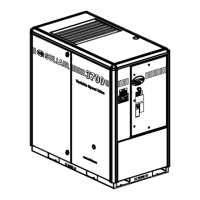SECTION 1
®SULLAIR®
4
3700 Operator’s Manual and Parts List
I. The antifreeze compound used in air line
antifreeze systems contains methanol and is
toxic, harmful or fatal if swallowed. Avoid contact
with the skin or eyes and avoid breathing the
fumes. If swallowed, induce vomiting by
administering a tablespoon of salt, in each glass
of clean, warm water until vomit is clear, then
administer two teaspoons of baking soda in a
glass of clean water. Have patient lay down and
cover eyes to exclude light. Call a physician
immediately.
1.8 ELECTRICAL SHOCK
A. This compressor should be installed and
maintained in full compliance with all applicable
Federal, State and Local codes, standards and
regulations, including those of the National
Electrical Code, and also including those relative
to equipment grounding conductors, and only by
personnel that are trained, qualified and
delegated to do so.
B. Keep all parts of the body and any hand-held tools
or other conductive objects away from exposed
live parts of electrical system. Maintain dry
footing, stand on insulating surfaces and DO NOT
contact any other portion of the compressor when
making adjustments or repairs to exposed live
parts of the electrical system. Make all such
adjustments or repairs with one hand only, so as
to minimize the possibility of creating a current
path through the heart.
C. Attempt repairs in clean, dry and well lighted and
ventilated areas only.
D. DO NOT leave the compressor unattended with
open electrical enclosures. If necessary to do so,
then disconnect, lock out and tag all power at
source so others will not inadvertently restore
power.
E. Disconnect, lock out, and tag all power at source
prior to attempting repairs or adjustments to
rotating machinery and prior to handling any
ungrounded conductors.
1.9 LIFTING
A. If the compressor is provided with a lifting bail,
then lift by the bail provided. If no bail is provided,
then lift by sling. Compressors to be air-lifted by
helicopter must not be supported by the lifting bail
but by slings instead. In any event, lift and/or
handle only in full compliance with OSHA
standards 29 CFR 1910 subpart N and/or any
applicable Federal, State, and Local codes,
standards and regulations.
B. Inspect points of attachment for cracked welds
and for cracked, bent, corroded or otherwise
degraded members and for loose bolts or nuts
prior to lifting.
C. Make sure entire lifting, rigging and supporting
structure has been inspected, is in good condition
and has a rated capacity of at least the weight of
the compressor. If you are unsure of the weight,
then weigh compressor before lifting.
D. Make sure lifting hook has a functional safety
latch or equivalent, and is fully engaged and
latched on the bail or slings.
E. Use guide ropes or equivalent to prevent twisting
or swinging of the compressor once it has been
lifted clear of the ground.
F. DO NOT attempt to lift in high winds.
G. Keep all personnel out from under and away from
the compressor whenever it is suspended.
H. Lift compressor no higher than necessary.
I. Keep lift operator in constant attendance
whenever compressor is suspended.
J. Set compressor down only on a level surface
capable of safely supporting at least its weight
and its loading unit.
A DANGER
All field equipment must be tested for
electrostatic fields prior to servicing or
making contact with the machine using
the following or equivalent test
equipment:
• 90-600 VAC: Volt detector such as Fluke
Model 1AC-A
• 600-7000 VAC: Voltage detector such as
Fluke Networks Model C9970
It is the responsibility of each
organization to provide/arrange training
for all their associates expected to test for
electrostatic fields.
SU_0000020

